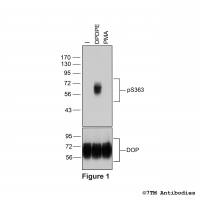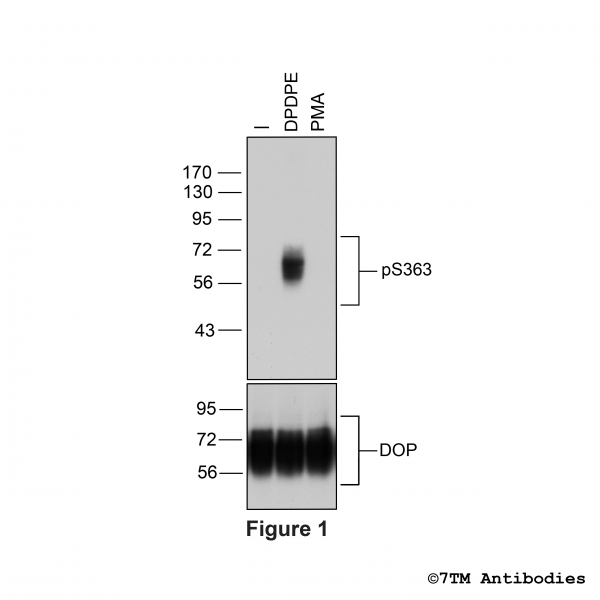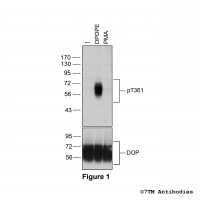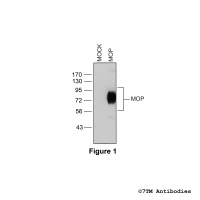Prices plus VAT plus shipping costs
Ready to ship today,
Delivery time appr. 5-8 days
- Order number: 7TM0317B
- Content: 100 µl
- Host: Rabbit
Serine363 (S363) is the primary phosphorylation site in a hierarchical phosphorylation cascade of the delta-opioid receptor (DOP). The pS363-DOP antibody detects phosphorylation in response to high- and low-efficacy agonists but not after PKC activation. S363 phosphorylation is a key regulator of DOP desensitization, β-arrestin recruitment and internalization. The pS363-DOP antibody can detect phosphorylated DOP in mouse brain in vivo. The pS363-DOP antibody can by used for detection of the subcellular location of phosphorylated DOP by immunocytochemistry.
| Alternative Names | DOP, OPRD1, δ-Opioid Receptor |
| IUPHAR Target ID | 317 |
| UniProt ID | P41143 (human) P32300 (mouse) P33533 (rat) |
| Western Blot (WB) | 1:1000 |
| Species Reactivity | Human, Mouse, Rat |
| Host / Isotype | Rabbit / IgG |
| Class | Polyclonal |
| Immunogen | A synthetic phosphopeptide derived from human DOP around the phosphorylation site of Ser363 |
| Form | Liquid |
| Purification | Antigen affinity chromatography |
| Storage buffer | Dulbecco's PBS, pH 7.4, with 150 mM NaCl, 0.02% sodium azide |
| Storage conditions | short-term 4°C, long-term -20°C |
Figure 1. Agonist-induced Serine363 phosphorylation of the δ-Opioid receptor. Upper panel, HEK293 cells stably expressing the δ-Opioid Receptor (DOP) were either not exposed or exposed to 10 μM DPDPE ([D-Pen2,D-Pen5]-enkephalin) or 0.1 μM PMA (Phorbol 12-Myristate 13-Acetate) for 30 minutes. Cells were lysed and immunoblotted with the anti-pS363-DOP antibody (7TM0317B) at a dilution of 1:1000. Lower panel, blot was stripped and reprobed with a phosphorylation-independent anti-DOP antibody to confirm equal loading of the gel.
Figure 2. Analysis of dose-dependent δ-Opioid Receptor phosphorylation using two phosphosite-specific antibodies. Upper two panels, HEK293 cells stably expressing the δ-Opioid Receptor (DOP) were either not exposed or exposed to increasing concentrations of selective δ-opioid receptor agonist SNC80 ranging from 1 nM to 10 μM for 30 minutes. Cells were lysed and immunoblotted with the anti-pT361-DOP antibody (7TM0317A) or anti-pS363-DOP antibody (7TM0317B) at a dilution of 1:1000. Lower panel, blot was stripped and reprobed with a phosphorylation-independent anti-DOP antibody to confirm equal loading of the gel.
Figure 3. Immunocytochemical identification of Serine363 phosphorylation of the δ-Opioid Receptor. HEK293 cells stably expressing the δ-Opioid Receptor (DOP) were either not exposed or exposed to 10 μM DPDPE ([D-Pen2,D-Pen5]-enkephalin) for 2, 5 or 30 min and immunocytochemically stained with the anti-pS363-DOP antibody (7TM0317B) at a dilution of 1:200. Note, Serine363-phosphorylated DOP receptors were not detectable in untreated cells (0 min). Serine363-phosphorylated DOP receptors were seen at the plasma membrane (2 min) and with increased time of stimulation (5 and 30 min) as perinuclear clusters.






















